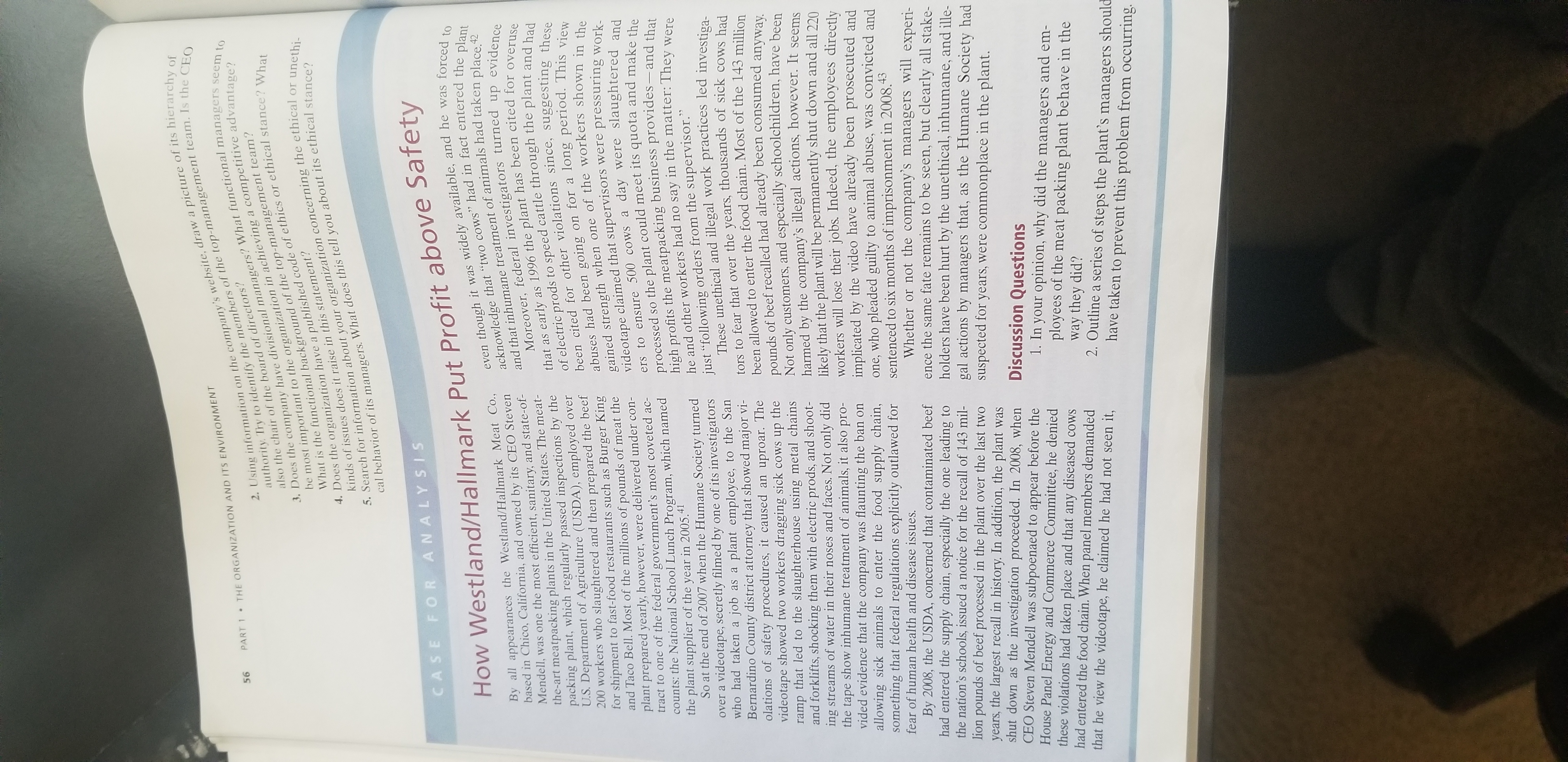Answered step by step
Verified Expert Solution
Question
1 Approved Answer
For this week's discussion, we are looking at the Case Analysis on page 56: How Westland/Hallmark Put Profit above Safety After Reading the case, please
For this week's discussion, we are looking at the Case Analysis on page 56: How Westland/Hallmark Put Profit above Safety
After Reading the case, please answer the 2 Discussion Questions
- In your opinion, why did the managers and employees of the meal packing plant behave in the way they did?

56 2. Using information on the company's website, draw a picture of its hierarchy of authority. Try to identify the members of the top-management team. Is the CEO also the chair of the board of directors? 3. Does the company have divisional managers? What functional managers kinds of issues does it raise in this statement? be most important to the organization in achieving a competitive advantage? What is the functional background of the top-management team? 4. Does the organization have a published code of ethics or ethical stance? What 5. Search for information about your organization concerning the ethical or unethi- cal behavior of its managers. What does this tell you about its ethical stance? PART 1 THE ORGANIZATION AND ITS ENVIRONMENT How Westland/Hallmark Put Profit above Safety By all appearances the Westland/Hallmark Meat Co., based in Chico, California, and owned by its CEO Steven Mendell, was one the most efficient, sanitary, and state-of- the-art meatpacking plants in the United States. The meat- packing plant, which regularly passed inspections by the U.S. Department of Agriculture (USDA), employed over 200 workers who slaughtered and then prepared the beef for shipment to fast-food restaurants such as Burger King and Taco Bell. Most of the millions of pounds of meat the plant prepared yearly, however, were delivered under con- tract to one of the federal government's most coveted ac- counts: the National School Lunch Program, which named the plant supplier of the year in 2005.41 So at the end of 2007 when the Humane Society turned over a videotape, secretly filmed by one of its investigators who had taken a job as a plant employee, to the San Bernardino County district attorney that showed major vi- olations of safety procedures, it caused an uproar. The videotape showed two workers dragging sick cows up the ramp that led to the slaughterhouse using metal chains and forklifts, shocking them with electric prods, and shoot- ing streams of water in their noses and faces. Not only did the tape show inhumane treatment of animals, it also pro- vided evidence that the company was flaunting the ban on allowing sick animals to enter the food supply chain, something that federal regulations explicitly outlawed for fear of human health and disease issues. CASE FOR ANALYSIS seem By 2008, the USDA, concerned that contaminated beef had entered the supply chain, especially the one leading to the nation's schools, issued a notice for the recall of 143 mil- lion pounds of beef processed in the plant over the last two years, the largest recall in history. In addition, the plant was shut down as the investigation proceeded. In 2008, when CEO Steven Mendell was subpoenaed to appear before the House Panel Energy and Commerce Committee, he denied these violations had taken place and that any diseased cows had entered the food chain. When panel members demanded that he view the videotape, he claimed he had not seen it, to acknowledge that "two cows" had in fact entered the plant and that inhumane treatment of animals had taken place.4 Moreover, federal investigators turned up evidence that as early as 1996 the plant has been cited for overuse of electric prods to speed cattle through the plant and had been cited for other violations since, suggesting these abuses had been going on for a long period. This view gained strength when one of the workers shown in the videotape claimed that supervisors were pressuring work- ers to ensure 500 cows a day were slaughtered and processed so the plant could meet its quota and make the high profits the meatpacking business provides and that he and other workers had no say in the matter: They were just "following orders from the supervisor. These unethical and illegal work practices led investiga- tors to fear that over the years, thousands of sick cows had been allowed to enter the food chain. Most of the 143 million pounds of beef recalled had already been consumed anyway. Not only customers, and especially schoolchildren, have been harmed by the company's illegal actions, however. It seems likely that the plant will be permanently shut down and all 220 workers will lose their jobs. Indeed, the employees directly implicated by the video have already been prosecuted and one, who pleaded guilty to animal abuse, was convicted and sentenced to six months of imprisonment in 2008.43 Whether or not the company's managers will experi- ence the same fate remains to be seen, but clearly all stake- holders have been hurt by the unethical, inhumane, and ille- gal actions by managers that, as the Humane Society had suspected for years, were commonplace in the plant. n to - Discussion Questions 1. In your opinion, why did the managers and em- ployees of the meat packing plant behave in the way they did? 2. Outline a series of steps the plant's managers should have taken to prevent this problem from occurring.
Step by Step Solution
There are 3 Steps involved in it
Step: 1

Get Instant Access to Expert-Tailored Solutions
See step-by-step solutions with expert insights and AI powered tools for academic success
Step: 2

Step: 3

Ace Your Homework with AI
Get the answers you need in no time with our AI-driven, step-by-step assistance
Get Started


